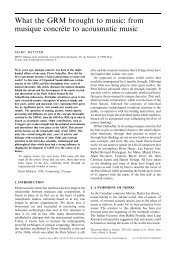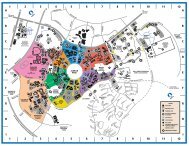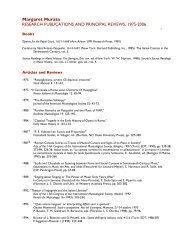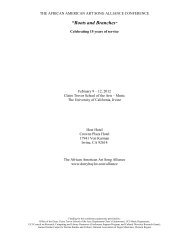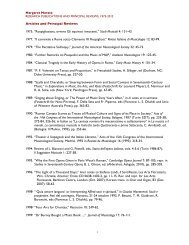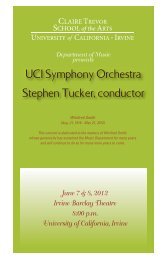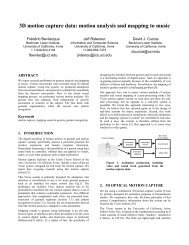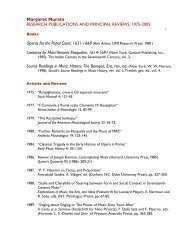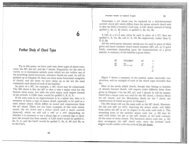amy bauer The Other of the Exotic: Balinese Music as Grammatical ...
amy bauer The Other of the Exotic: Balinese Music as Grammatical ...
amy bauer The Other of the Exotic: Balinese Music as Grammatical ...
Create successful ePaper yourself
Turn your PDF publications into a flip-book with our unique Google optimized e-Paper software.
<strong>The</strong> <strong>O<strong>the</strong>r</strong> <strong>of</strong> <strong>the</strong> <strong>Exotic</strong> 347<br />
Ex. 5 Recursive patterns, ubit telu and ubit empat, and combined pitch series in bars<br />
1–2 <strong>of</strong> Ex. 3<br />
ubit telu: three notes per part,<br />
one shared note per beat<br />
ubit empat: two notes each part, no overlap<br />
Kotekan<br />
Pokok<br />
G G G G G G<br />
Combined pitch series: E G D E G E G E G A E G E D C E C D E C D C E D C E D E C D<br />
Kempyung: C / G<br />
crotchet level <strong>of</strong> <strong>the</strong> structure employs eight patterns; three <strong>of</strong> <strong>the</strong>se occur<br />
twice, while three o<strong>the</strong>rs occur twelve times or more. Fifteen different patterns<br />
exist at <strong>the</strong> minim (two-beat) level <strong>of</strong> structure: five <strong>of</strong> those are unique, five<br />
occur twice, and five occur three times or more. Ex. 4 shows <strong>the</strong> relations<br />
among patterns found at <strong>the</strong> four- and eight-beat structural levels. Six <strong>of</strong> <strong>the</strong><br />
ten patterns at <strong>the</strong> one-beat level repeat; at <strong>the</strong> eight-beat level, only two <strong>of</strong> <strong>the</strong><br />
six patterns repeat.<br />
Every level <strong>of</strong> structure in <strong>the</strong> gong kebyar repertory reflects this concern for a<br />
subtle balance between symmetry and irregularity. In his discussion <strong>of</strong> compositional<br />
procedure within <strong>the</strong> highly syncopated ubit-ubitan style (see again<br />
Ex. 2),Tenzer analyses <strong>the</strong> repeated three-note patterns which ornament a neliti.<br />
<strong>The</strong> patterns are inversionally symmetrical at each <strong>of</strong> eight possible positions<br />
within <strong>the</strong> five-note system. For Tenzer, this observation ‘seems abstract,<br />
but ... is completely audible, and provides a rigorous perspective on <strong>the</strong> music’s<br />
overall melodic coherence’ (2000a, pp. 222–3). <strong>The</strong> distorted symmetry created<br />
by <strong>the</strong> circulation <strong>of</strong> larger patterns in diminution prolongs <strong>the</strong> underlying<br />
melody, creates syncopation and stabilises – by intensifying – a narrow band <strong>of</strong><br />
pitch and timbre. For a brief example <strong>of</strong> how this works, I will again refer to <strong>the</strong><br />
first eight beats <strong>of</strong> Ex. 2, reprinted <strong>as</strong> Ex. 5. Each individual kotekan part is<br />
attacked two or three times per beat using different but overlapping two- and<br />
three-pitch collections (bars 2 and 1 respectively). <strong>The</strong> combined pitch series <strong>of</strong><br />
<strong>the</strong> kotekan on beat 1 is a microcosm <strong>of</strong> beats 1–4 <strong>of</strong> <strong>the</strong> pokok. <strong>The</strong> combined<br />
pitch series on beats 5–8, punctuated by <strong>the</strong> kempyung interval, permutes every<br />
possible combination <strong>of</strong> <strong>the</strong> three-element series C ♯ /G–D–E.<br />
Gamelan gong in ‘Galamb borong’<br />
<strong>The</strong> three primary levels <strong>of</strong> rhythmic structure in Ligeti’s ‘Galamb borong’ can<br />
be compared in both form and function to <strong>the</strong> ‘tree’ <strong>of</strong> gamelan gong kebyar. A<br />
consistent semiquaver attack in each hand occupies <strong>the</strong> kotekan level <strong>of</strong> <strong>the</strong><br />
Étude, while a pokok travelling in larger values creates a second rhythmic level.<br />
Aperiodic accents in this melody establish a third, slower-moving stratum <strong>of</strong><br />
melodic motion, a pitch series subject to augmentation or diminution.<br />
<strong>Music</strong> Analysis, 27/ii-iii (2008)<br />
© 2009 <strong>The</strong> Author.<br />
Journal compilation © 2009 Blackwell Publishing Ltd.



